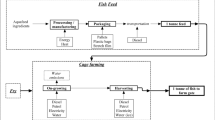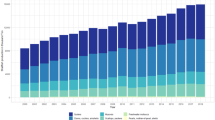Abstract
Purpose
In order to meet the upscaling demand of food products worldwide, the aquaculture industry has been expanding within the last few years in developed countries. Major expansions of aquaculture farming occurred in many developed countries such as Bangladesh, Indonesia, and Egypt. Egypt ranks ninth in fish farming production worldwide and first on Africa. Egypt has the largest aquaculture industry in Africa which represents two-thirds of African aquaculture production. Tilapia production accounts for 75.5 % of aquaculture production in Egypt. Tilapia aquaculture production has grown exponentially in recent decades until it reached 4.5 million tonnes in 2012 placing Egypt as the second worldwide producer of tilapia after China. The production of tilapia is practiced in different production systems including intensive and semi-intensive systems. These production systems require different resources and impact differently on the environment. The aim of the current study was to model the environmental performance of tilapia production and compare semi-intensive and intensive production systems. The main questions were the following: What are the different impacts of tilapia production on the environment? Which production system is more environmentally friendly? What are the preferable practices for better environmental performance and sustainable ecofriendly industry of Tilapia production?
Methods
Life cycle assessment (LCA) was employed to determine the environmental impacts of tilapia production and compare semi-intensive and intensive production systems. Data for life cycle inventory were collected from two case study farms for tilapia production in Egypt. Four impact categories were taken into consideration: Global Warming Potential (GWP), Acidification Potential (AP), Eutrophication Potential (EP), and Cumulative Energy Demand (CED).
Results and discussion
LCA revealed that production of tilapia in intensive farming has less impact on GWP, AP, and CED, while its impact on EP is higher than in semi-intensive farming. The identified impacts from 1-tonne live weight production of tilapia were the following: GWP 960.7 and 6126.1 kg CO2 eq; AP 9.8 and 24.4 kg SO2 eq; EP 14.1 and 6.3 kg PO2 eq; and CED 52.8 GJ and 238.3 GJ eq in intensive and semi-intensive systems, respectively.
Conclusions
Fish meal production and energy consumption were the major contributors to different impact indicators in both systems. An overall improvement in environmental performance for tilapia production can be achieved by novel feed formulations that have better environmental performance. Energy consumption is a major area for improvement as well, as proper energy management practices will reduce the overall impact on the environment.







Similar content being viewed by others
References
Aubin J, Papatryphon E, van der Werf HMG, Chatzifotis S (2009) Assessment of the environmental impact of carnivorous finfish production systems using life cycle assessment. J Clean Prod 17:354–361
Ayer N, Tyedmers P, Pelletier N, Sonesson U, Scholz AJ (2007) Co-product allocation in life cycle assessments of seafood production systems: review of problems and strategies. Int J Life Cycle Assess 12:480–487
Ayer NW, Tyedmers PH (2009) Assessing alternative aquaculture technologies: life cycle assessment of salmonid culture in Canada. J Clean Prod 17:362–373
Avadí A, Pelletier N, Aubin J, Ralite S, Núñez J, Fréon P (2015) Comparative environmental performance of artisanal and commercial feed use in Peruvian freshwater aquaculture. Aqua 435:52–66
Baker JW, Lepech MD (2009) Treatment of uncertainties in life cycle assessment. In Intl. Congress on Structral Safety and Reliability
Buchspies B, Sunnie T, Niels J (2011) Life Cycle Assessment of High-Sea Fish and Salmon Aquaculture. ESU-services Ltd., fair consulting in sustainability, Uster, Switzerland
CAPMAS (2011) Egypt in figures report .2011. Central Agency for Public Mobilization and Statistics
CAPMAS (2014) Egypt in figures report .2014. Central Agency for Public Mobilization and Statistics
Cao L, Diana JS, Keoleian GA, Lai Q (2011) Life cycle assessment of Chinese shrimp farming systems targeted for export and domestic sales. Environ Sci Technol 45:6531–6538
Cao L, Diana JS, Keoleian GA (2013) Role of life cycle assessment in sustainable aquaculture. Rev Aqua 5:61–71
Chen X, Samson E, Tocqueville A, Aubin J (2015) Environmental assessment of trout farming in France by life cycle assessment: using bootstrapped principal component analysis to better define system classification. J Clean Prod 87:87–95
Diana JS (2009) Aquaculture production and biodiversity conservation. Bioscience 59:27–38
El-Sayed AFM (2007) Analysis of feeds and fertilizers for sustainable aquaculture development in Egypt. FAO Fisheries Technical Paper No 497:401–422
El-Sayed AFM (2014) Value chain analysis of the Egyptian aquaculture feed industry. WorldFish, Penang, Malaysia. Project Report: 2014–22
Ellingsen H, Olaussen JO, Utne IB (2009) Environmental analysis of the Norwegian fishery and aquaculture industry – a preliminary study focusing on farmed salmon. Mar Pol 33:479–488
Eltholth M, Fornace K, Grace D, Rushton J, Häsler B (2015) Characterisation of production, marketing and consumption patterns of farmed tilapia in the Nile Delta of Egypt. Food Pol 51:131–143
FAO (2010) Fishstat Plus Universal software for fishery statistical time series. Aquaculture Production: 1950–2007; Capture Fisheries 1950–2007 [Vers.2.30]. FAO Fisheries Department, Fishery Information, Data and Statistics Unit, Rome
FAO (2014) The State of World Fisheries and Aquaculture 2014. FAO Fisheries Department, Fishery Information, Data and Statistics Unit, Rome, Italy
FAO (2016) A world overview of species of interest to fisheries. Oreochromis niloticus. FIGIS Species Fact Sheets. FAO Fisheries and Aquaculture Department. Rome, Italy. [Cited 21 January 2016]
Feidi I (2010) Tilapia market in the Middle East and North Africa: demand trends and outlook. Third international trade conference and exposition on Tilapia. 27–29th October, Kuala Lumpur, Malaysia
Fitzsimmons K (2000) Tilapia and penaeid shrimp polycultures. Pond Dynamics/Aquaculture CRSP, Aquanews, Fall 2000
FishStat (2009) www.fao.org/fishery/statistics/en. Accessed October 2008
Firshknecht R, Jungbluth N (2007) Implementation of life cycle assessment methods. Swiss center for life cycle inventories, The Netherlands
GAFRD (General Authority for Fisheries Resources Development) (2013) Fisheries Statistics Year Book 2012. Cairo, GAFRD
Goedkoop M, Spriensma R (2000) Eco-indicator 99 methodology report. PRÃ Consultants, The Netherlands
Gronroos J, Seppala J, Silvenius F, Ma kinen T (2006) Life cycle assessment of Finnish cultivated rainbow trout. Bor Env Res 11:401–414
Henriksson PJG, Guinée JB, Kleijn R, de Snoo GR (2012) Life cycle assessment of aquaculture systems—a review of methodologies. Int J Life Cycle Assess 17:304–313
ISO14040 (2006) International Organization for Standardizations: Environmental Management—life cycle assessment—principles and frameworks. Switzerland, Geneva
ISO14044 (2006) International Organization for Standardizations: Environmental Management—life cycle assessment—requirements and guidelines. Switzerland, Geneva
Iribarren D, Moreira MT, Feijoo G (2010) Life Cycle Assessment of fresh and canned mussel processing and consumption in Galicia (NW Spain). Res Con Rec 55(2):106–117
Iribarren D, Moreira MT, Feijoo G (2012) Life Cycle Assessment of Aquaculture Feed and Application to the Turbot Sector. Int J Environ Res 6(4):837–848
Jerbi M, Aubin J, Garnaoui K, Achour L, Kacem A (2012) Life cycle assessment (LCA) of two rearing techniques of sea bass (Dicentrarchus labrax). Aqua Eng 46:1–9
Macfadyen G, Nasr-Allah A, Dickson M (2012) The market for Egyptian farmed fish. WorldFish Center, Egypt
Mjoun K, Rosentrater KA, Brown ML (2010) Tilapia: profile and economic importance. Iowa State University, South Dakota Cooperative Extension Service, USDA, USA
Mungkung RT, Udo De Haes HA, Clift R (2006) Potentials and limitations of life cycle assessment in setting ecolabelling criteria: a case study of Thai shrimp aquaculture product. Int J Life Cycle Assess 11:55–59
Mungkung RT, Aubin J, Prihadi TH, Slembrouck J, van der Werf HMG, Legendre M (2013) Life Cycle Assessment for environmentally sustainable aquaculture management: a case study of combined aquaculture systems for carp and tilapia. J Clean Prod 57:249–256
Mur R (2014) Development of the aquaculture value chain in Egypt: report of the National Innovation Platform Workshop, Cairo, 19–20 February 2014. WorldFish, Cairo
Nasr-Alla A, Kenawy D, El-Naggar G, Beveridge M, Van der Heijden PGM (2012) Evaluation of the use of freshwater by four Egyptian farms applying aquaculture – agriculture integration. Study report. Centre for Development Innovation, Wageningen University & Research Center
Osman MF, Sadek SS (2004) An overview of fish feed industry in Egypt – challenges and opportunities. Expert Consultation on Fish Nutrition Research and Feed Technology in Egypt. Abbassa, Abou Hammad, Sharkia, Egypt, 2nd December, 2004, WorldFish Center. (Unpublished)
Pelletier N, Tyedmers P (2010) Life cycle assessment of frozen tilapia fillets from Indonesian lake-based and pond-based intensive aquaculture systems. J Ind Ecol 14:467–481
Pelletier N, Tyedmers P, Sonesson U, Scholz A, Ziegler F, Flysjo A et al (2009) Not all salmon are created equal: life cycle assessment (LCA) of global salmon farming systems. Environ Sci Technol 43:8730–8736
Pelletier NL, Ayer NW, Tyedmers PH, Kruse SA, Flysjo A, Robillard G et al (2007) Impact categories for life cycle assessment research of seafood production systems: review and prospectus. Int J Life Cycle Assess 12:414–421
Phong LT, de Boer IJM, Udo HMJ (2011) Life cycle assessment of food production in integrated agriculture–aquaculture systems of the Mekong Delta. Liv Sci 139:80–90
Pongpat P, Tonnegpool R (2013) Life cycle assessment of fish culture in Thailand: case study of Nile tilapia and striped catfish. Int J Env Sc Dev 4(5):608–612
Rokey GJ, Plattner B, Souza EM (2010) Feed extrusion process description. Rev Bras Zootec 39:510–518
Roque d’Orbcastel E, Blanchetonnene JP, Aubin J (2009) Towards environmentally sustainable aquaculture: comparison between two trout farming systems using Life Cycle Assessment. Aqu Eng 40:113–119
Rothuis A, Pieter van Duijn A, Roem A, Ouwehand A, piji W, Rurangwa E (2013) Aquaculture business opportunities in Egypt. Wageningen, Wageningen UR (University & Research centre). LEI report 2013–039, IMARES report C091/13
Samuel-Fitwi B, Nagel F, Meyer S, Schroder JP, Schulz C (2013) Comparative life cycle assessment of raising rainbow trout (Oncorhynchus mykiss) in different production systems. Aquaclt Eng 54:85–92
Shaheen AA, Seisay M, Nouala S (2013) An industry assessment of tilapia farming in Egypt. African Union – Inter-African Bureau for Animal Resources (AU-IBAR), Nairobi, Kenya
Soliman NFE, Yacout DMM (2016) The prospects of analyzing the environmental impacts of Egyptian aquaculture using life cycle assessment. International Journal of Aquaculture (in Press)
Van der Velden NM, Patel MK, Vogtländer JG (2014) LCA benchmarking study on textiles made of cottonne, polyester, nylon, acrylc, or elastane. Int J Life Cycle Assess 19:331–356
Vázquez-Rowe I, Hospido A, Moreira MT, Feijoo G (2012) Best practices in life cycle assessment implementation in fisheries. Improving and broadening environmental assessment for seafood production systems. Trends Food Sci Tech 28(2):116–131
Acknowledgments
The authors would like to express their thanks and gratitude to Dr. Mohamed Baromah (National Institute of Oceanography, Egypt) for his cooperation, support, and consultancy during the study period.
Author information
Authors and Affiliations
Corresponding author
Additional information
Responsible editor: Ian Vázquez-Rowe
Rights and permissions
About this article
Cite this article
Yacout, D.M.M., Soliman, N.F. & Yacout, M.M. Comparative life cycle assessment (LCA) of Tilapia in two production systems: semi-intensive and intensive. Int J Life Cycle Assess 21, 806–819 (2016). https://doi.org/10.1007/s11367-016-1061-5
Received:
Accepted:
Published:
Issue Date:
DOI: https://doi.org/10.1007/s11367-016-1061-5




